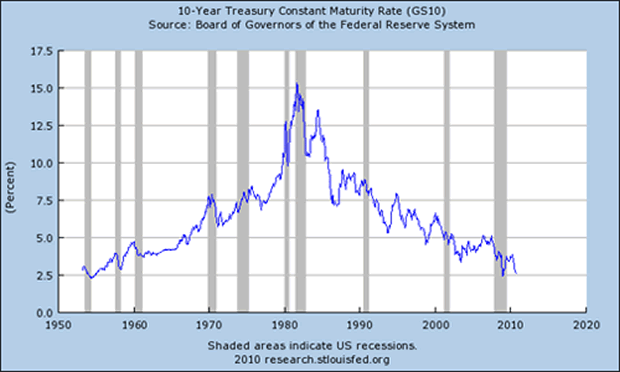Results 1 to 1 of 1
Thread Information
Users Browsing this Thread
There are currently 1 users browsing this thread. (0 members and 1 guests)
-
10-28-2010, 02:07 AM #1Senior Member


- Join Date
- May 2007
- Location
- South West Florida (Behind friendly lines but still in Occupied Territory)
- Posts
- 117,696
U.S. Treasury Bond Bubble about to POP!
U.S. Treasury Bond Bubble about to POP!
Interest-Rates / US Bonds
Oct 27, 2010 - 09:21 AM
By: Claus_Vogt
Financial history shows that interest rates — and hence bond prices — have risen and fallen in long-term trends spanning decades. The following chart shows the 10-year Treasury since 1953.
As you can see, rates started rising shortly after the recession that ended in May 1954. In the second half of the 1960s this uptrend gathered speed. The market seemed to smell high inflation coming in the 1970s. And by the end of that decade and into 1980/81 rates soared. In fact, they peaked at slightly more than 15 percent — six times higher than the 1954 low!

Paul Volcker became chairman of the Federal Reserve in 1979. His agenda was to break the inflation cycle, no matter what. So he curbed the money supply growth by letting interest rates rise as high as necessary to achieve that goal.
Secular Downtrend Since 1981
Volcker succeeded. And by 1981 the secular downtrend in interest rates began.
Most market participants did not believe in the durability of Volcker’s victory over inflation. They didn’t realize the importance of the rate’s high in 1981 and bond market’s low.
Soon after the severe recession of 1981/82, rates started rising — even though inflation had dropped. They hit an important secondary high in mid-1984 only to start falling again … but in earnest.
Here we are in 2010, 29 years after the spectacular high rate of 1981. And yields for many short- to medium-term Treasuries — up to five years — have just reached new lows for this secular trend.
Indeed, 29 years is a long time, even for secular interest rate trends. So I’ve been looking for signs of an impending trend change, which could easily turn out to be of major importance.
However, markets often continue their long-term trends in spite of major changes in fundamentals …
They tend to continue — habitually if you will — even though the original fundamental forces driving the trend for a long time have silently faded and made room for opposite forces.
My impression is that the bond markets have finally reached that point …
We have skyrocketing government deficits throughout the world and outspoken inflationary goals. At the same time, Ben Bernanke’s Fed and his international brethren seem to ignore the longer-term implications of currency debasement that their fiscal and monetary policies are leading to.
And I see …
Three Subtle Signs of an Impending Trend Change
First, is the huge money inflow that has bond mutual fund managers so excited. Bond fund monthly inflows are rivaling those of stock mutual funds during their record year of 2000. Unfortunately financial history is telling us that whenever a market is being discovered by the masses it’s in the final stages of a secular bull market.
Second, the chart pattern for Treasury yields may very well turn out to be a major bottom formation — a huge double-bottom. The first was a panic low associated with the banking crisis of 2008. The second low is currently in the process of being formed.
Speculating on a new round of what the Fed has named “quantitative easing,â€Join our efforts to Secure America's Borders and End Illegal Immigration by Joining ALIPAC's E-Mail Alerts network (CLICK HERE)


 LinkBack URL
LinkBack URL About LinkBacks
About LinkBacks




 Reply With Quote
Reply With Quote

SoCal: Large Group of Illegal Aliens Dock Boat in Newport Beach,...
05-03-2024, 12:07 PM in illegal immigration News Stories & Reports